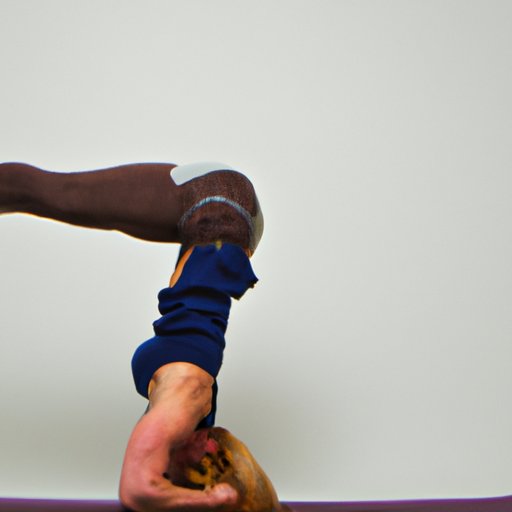Introduction
The yoga headstand is one of the most challenging poses in the practice of yoga. It requires strength, flexibility, balance, and concentration to perform. However, with proper preparation and guidance, anyone can learn how to do a yoga headstand.
What is a yoga headstand? Also known as sirsasana, the yoga headstand is an inverted pose where the body is balanced on the head and arms, with the legs either bent in a squatting position or straightened up into the air. This pose has many benefits, from improved blood circulation to increased focus and mental clarity.
Step-by-Step Guide: How to Do a Yoga Headstand
Before attempting the yoga headstand, it is important to warm up the body and prepare it for the pose. Here is a step-by-step guide on how to do a yoga headstand:
Preparation
Begin by finding a comfortable spot on the floor, such as a yoga mat or a carpeted area. Place a folded blanket near your head, as this will be used as a cushioning surface.
Positioning your body
Kneel down on the floor and place your hands on the ground. Make sure that your elbows are shoulder-width apart and your palms are flat against the ground. Your fingertips should be pointing towards your feet.
Moving into the pose
Inhale deeply and slowly begin to walk your feet closer to your head. As you exhale, lift your knees off the ground and tuck your toes under. Keep your core engaged and your back straight. Slowly lower your head onto the folded blanket.
Finishing the pose
Once your head is firmly placed on the blanket, inhale deeply and slowly lift your legs up towards the ceiling. Make sure to keep your core engaged and your back straight. Hold the pose for five to 10 breaths, then slowly lower your legs back to the ground.
A Beginner’s Guide to the Perfect Yoga Headstand
For beginners, it is important to choose the right surface when practicing the yoga headstand. A hardwood or tile floor is ideal, as it provides enough traction for the hands and feet. It is also important to understand the anatomy of the pose. When performing the yoga headstand, make sure that your shoulders are directly over your wrists and your hips are directly over your shoulders.
Practicing with props can also help beginners gain confidence in the pose. It is recommended to use a wall for support. Stand facing the wall and place your hands on the floor. Slowly walk your feet up the wall until your hips are in line with your shoulders. Hold the pose for a few breaths, then slowly lower your feet back to the floor.

Tips on Mastering the Yoga Headstand
Mastering the yoga headstand takes time and dedication. Working on your balance is essential to achieving the perfect headstand. Try to keep your weight evenly distributed between your hands and feet. Building strength and flexibility in your core muscles will also help you stay steady in the pose.
Developing concentration is another key factor in mastering the yoga headstand. Focus on your breath and try to remain calm and still throughout the pose. This will help you stay focused and balanced in the pose.

Benefits of Doing a Yoga Headstand
The yoga headstand has many benefits. It increases blood circulation to the brain, which helps to improve focus and mental clarity. It also strengthens the core muscles and improves posture. In addition, it can help to reduce stress and anxiety.
How to Achieve Balance in a Yoga Headstand
Achieving balance in a yoga headstand requires practice and patience. Finding your center of gravity is essential to staying balanced. Engaging your core muscles will also help you stay steady in the pose. Additionally, using props such as a block or a wall can provide extra support while you practice.
Common Mistakes to Avoid When Doing a Yoga Headstand
When practicing the yoga headstand, it is important to avoid common mistakes. Rushing the pose can lead to injury, so it is important to move slowly and deliberately. Not engaging your core can cause instability and imbalance, so make sure to keep your core muscles engaged throughout the pose. Finally, not breathing properly can lead to dizziness, so focus on your breath and take deep, steady breaths.

Proven Techniques for Doing a Yoga Headstand
There are several proven techniques for doing a yoga headstand. Practicing proper alignment is essential to achieving balance in the pose. Make sure that your shoulders are directly over your wrists and your hips are directly over your shoulders. Focusing on your breath is also important. Take deep, steady breaths and remain calm and still throughout the pose. Finally, using props such as blocks or a wall can provide extra stability and support.
Conclusion
The yoga headstand is an advanced pose that requires strength, flexibility, balance, and concentration. With proper preparation and guidance, anyone can learn how to do a yoga headstand. Remember to choose the right surface, understand the anatomy of the pose, and practice with props. Work on your balance, build strength and flexibility, and develop concentration. Finally, avoid common mistakes such as rushing the pose and not engaging your core. With these tips, you will be able to master the yoga headstand and reap its many benefits.


